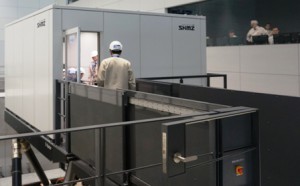Earthquake-Resistant Architecture and City Building Advanced Earthquake-Resistance Research by a Construction Company
post date : 2015.03.16
Earthquake-Resistant Architecture and City Building
Advanced Earthquake-Resistance Research by a Construction Company
Authors: FPCJ Interns Chihiro Kobayashi & Hana Hirose
Four years have passed since the 2011 Great East Japan Earthquake. Efforts to apply the lessons learned to disaster prevention in the future are underway in a variety of fields. Shimizu Corporation (president: Yoichi Miyamoto) is no exception, having finished construction on and begun operations at the Advanced Earthquake Engineering Laboratory built on the premises of the Shimizu Institute of Technology (Koto-ku, Tokyo), with the goal of applying the lessons learned to research in earthquake countermeasures as soon as possible. With two of the most advanced shaking tables in the industry installed, research is being carried out on both technical and human-based aspects, through experiments in these cutting-edge facilities and risk analyses of the experimental data.
[The Advanced Earthquake Engineering Laboratory’s two shaking tables, the E-Beetle (foreground) and the E-Spider (background)]
According to Shimizu, Japanese construction standards are strict from an international perspective, but buildings built before the Buildings Standards Act was significantly revised in 1981 are insufficiently earthquake resistant or reinforced. Many of the buildings damaged in earthquakes such as the 1995 Great Hanshin Earthquake belong to this category. Shimizu has been researching earthquake countermeasures since the 1970s, but after the Great East Japan Earthquake “exceeded expectations,” construction began on a new research facility in June 2013 that could carry out high-level experiments on all kinds of possible earthquakes, massive or otherwise.
The newly completed research facility includes two shaking tables, the E-Beetle (large-scale shaking table, 7 m × 7 m) and the E-Spider (large-stroke shaking table, 4 m × 4 m)*. The E-Beetle can reproduce earthquakes with acceleration and displacement greater than any earthquake observed so far worldwide, as well as different types such as inland earthquakes and subduction-zone earthquakes. It will aid in discovering the mechanisms of building collapse, and the earthquake resistance properties of building fixtures and features such as ceilings. The E-Spider can reproduce long-period, large-stroke motions in three dimensions (horizontal, vertical, and rotational). This makes it possible to study how super-high-rise buildings sway and the movement of furniture inside rooms. By mounting a cabin on the shaking table that people can enter, it is also possible to study the effects of earthquakes on human psychology and behavior. Data from these experiments will be incorporated into future construction methods.
*The ’Beetle’ in the name comes from the table’s powerful, beetle-like appearance, and ‘Spider’ is from that table’s shape and movements. The ‘E’ in both names refers to the first letters of Earthquake, Examination, Enhance, and Excellence.
[Experiment using E-Beetle (large-scale shaking table)]
On March 4, the new research facility was opened to foreign media and experiments were held using the two shaking tables. The experiment with the E-Beetle used a miniaturized model (3.8 m, 13 t) of a 150 m, 40-story super-high rise building, and reproduced the shaking (Japan Meteorological Agency seismic intensity of 6-lower) observed in Miyagino, Sendai during the Great East Japan Earthquake. It was clear that sections of the model shifted more the higher up they were (see photos above). The E-Spider reproduced four types of earthquake motions: 1) intensity 3 and 4 (on the ground), 2) intensity 6-upper (5th floor of a non-seismic isolated apartment), 3) intensity 6-upper (5th floor of a seismic isolated apartment), and 4) the Great East Japan Earthquake in Tokyo (24th floor of a super-high-rise building). The screen inside the cabin displayed furniture moving in sync with the motion of the shaking table (see pictures below). The comparison with 2) and 3) between having seismic isolation and not having it reproduced motion similar to the upwards thrusting of the Great Hanshin Earthquake (stroke reduced by 50% for safety reasons), and 4) reproduced the large, long sideways motions (long-period motions) unique to super-high-rise buildings. By providing these earthquake simulations, Shimizu hopes to contribute to disaster-prevention awareness.
[Earthquake simulations using the E-Spider (large-stroke shaking table)
-------------------------------------------------------------------------------------------------------------------------------
Intern’s Notes
Chihiro Kobayashi
Through the earthquake experience program at Shimizu Corporation, I felt the horror of earthquakes again, and at the same time, I was surprised at the technology of seismic isolation construction. In the case of intensity 6 in the non-seismic isolation building, it was difficult to keep my balance even though I was holding a handrail. On the other hand, in the seismic isolation building, sideways motion was reduced significantly and the difference in shaking was obvious. Furthermore, the living room which was projected by CG was very dangerous after the earthquake in the non-seismic isolation building because the bookshelf and vases fell down. In contrast, the seismic isolation building only suffered a little damage, such as a swaying light. Therefore, I could both experience and see the effects of seismic isolation building very clearly. In order to prepare for the big earthquake, which is unavoidable, I expect that these two new shaking tables will play a very important role in the future of earthquake resistant construction.
Hana Hirose
The earthquake experiment was a very interesting experience for me since I have not experienced major earthquake yet. In particular, the comparison experiment with the non-seismic isolation structure and seismic isolation structure convinced me the results of the adoption of a seismic isolation structure, which is very effective at reducing the shaking which people actually experience in a building. I felt a strongly the necessity of seismic isolation technology. But I also felt a little anxious to hear the fact that around 30% of the buildings in Tokyo today do not have seismic isolation. The question "When an earthquake occurs, where is the safest place in Tokyo?" arose from the foreign media, and the answer from Shimizu was actually outside of Tokyo. However, there are also efforts being carried out for adding seismic isolation equipment to existing buildings. I look forward to their future activities.









